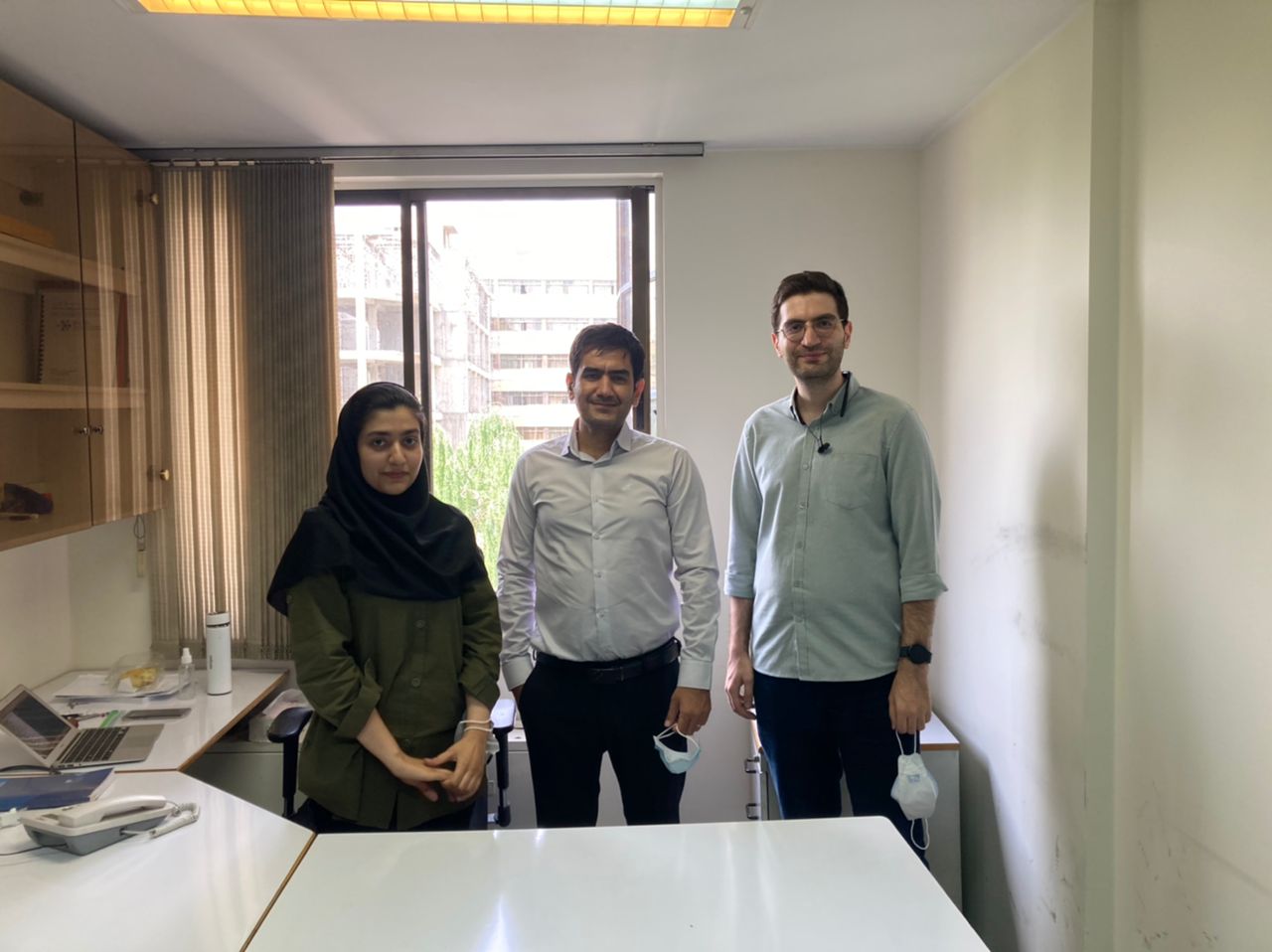دستاوردها
مقالات منتشر شده در مجلات علمی معتبر:
B. Lim, et al., “Magnetophoretic circuits for digital control of single particles and cells”, Nature Communications, 2014, 5, 3846.
R. Abedini-Nassab, et al., “Optimization of magnetic switches for single particle and cell transport”, Journal of Applied Physics, 2014, 115(24), 244509.
L. Li, et al., “Monolithically integrated Helmholtz coils by 3- dimensional printing”, Applied Physics Letters, 2014, 104(25), 253505.
R. Abedini Nassab and M. Eslamian, “Recent Patents and Advances on Application of Magnetic Nanoparticles and Thin Films in Cell Manipulation”, Recent Patents on Nanotechnology, 2014, 8(3), 157-164. (Editor’s Choice)
R. Abedini-Nassab, et al., “Characterizing the switching thresholds of magnetophoretic transistors”, Advanced Materials, 2015, 27(40), 6176-6180.
X. Hu, et al., “Dynamic trajectory analysis of superparamagnetic beads driven by on-chip micromagnets”, Journal of Applied Physics, 2015, 118(20), 203904.
R. Abedini-Nassab, et al., “Magnetophoretic Conductors and Diodes in a 3D Magnetic Field”, Advanced Functional Materials, 2016, 26(22), 4026-4034.
R. Abedini-Nassab, et al., “Magnetophoretic Transistors in a 3-Dimensional Magnetic Field”, Lab on a Chip, 2016, 16, 4181-4188.
D. Y. Joh, et al., “Poly(oligo(ethylene glycol) methyl ether methacrylate) Brushes on High-κ Metal Oxide Dielectric Surfaces for Bioelectrical Environments”, ACS Applied Materials & Interfaces, 2017, 9(6), 5522-5529. (Co-first author)
R. Abedini-Nassab, “Nanotechnology and Nanopore Sequencing”, Recent Patents on Nanotechnology, 2017, 11(1), 34-41. (Editor’s Choice)
R. Abedini-Nassab and R. Shourabi, “Bends in magnetophoretic conductors”, AIP Advances, 2019, 9(12), 125121.
R. Abedini-Nassab, "Magnetomicrofluidic Platforms for Organizing Arrays of Single-Particles and Particle-Pairs", IEEE Journal of Microelectromechanical Systems, 2019, 28(4).
R. Abedini-Nassab and N. Mahdaviyan, “A Microfluidic Platform Equipped with Magnetic Nano Films for Organizing Bio-Particle Arrays and Long-Term Studies”, IEEE Sensors, 2020.
R. Abedini-Nassab, “Magnetophoretic Circuit Biocompatibility”, Journal of Mechanics in Medicine and Biology, 2020, 20(7), 2050050.
R. Abedini-Nassab and N. Mahdaviyan, “Recent Patents and Advances on Nanotechnologies against Coronavirus”, Recent Patents on Nanotechnology, 2021, 15(4), 322-330.
R. Abedini-Nassab, S. M. Emami, and A. Naeimi Nowghabi, “Nanotechnology and Acoustic in Medicine and Biology”, Recent Patents on Nanotechnology, 2021, 16(3), 198-206.
R. Abedini-Nassab and S. Bahrami, “Synchronous control of magnetic particles and magnetized cells in a tri-axial magnetic field”, Lab on a Chip, 21(10), 1998-2007.
M. Mantri, G. J Scuderi, R. Abedini-Nassab, M. FZ Wang, D. McKellar, H. Shi, B. Grodner, J. T. Butcher, I. De Vlaminck, “Spatiotemporal single-cell RNA sequencing of developing hearts reveals interplay between cellular differentiation and morphogenesis”, Nature Communications, 2021, 12(1), 1-13.
R. Abedini-Nassab, M. Pouryosef Miandoab, M. Şaşmaz, “Microfluidic Synthesis, Control, and Sensing of Magnetic Nanoparticles: A Review”, Micromachines, 2021, 12(7), 768.
R. Abedini-Nassab, “Magnetometamaterials: Metamaterials with tunable magnetic matter conductivity”, Physical Review Applied, 2022, 17(1), 014020.
R. Abedini-Nassab, X. Ding, and H. Xie, “A novel magnetophoretic-based device for magnetometry and separation of single magnetic particles and magnetized cells”, Lab on a Chip, 2022, 22, 738-746.
R. Abedini-Nassab and R. Shourabi, “High-Throughput Precise Particle Transport at Single-Particle Resolution in a Three-Dimensional Magnetic Field for Highly Sensitive Bio-Detection”, Scientific Reports, 2022, 12(1), 1-15.
R. Abedini-Nassab, J. Wirfel, B. Talebjedi, N. Tasnim, and M. Hoorfar “Quantifying the Dielectrophoretic Force on Colloidal Particles in Microfluidic Devices”, Microfluidics and Nanofluidics, 2022, 26 (38).
X. Wang, J. He, Sh. Jin, H. Liu, H. Li, H. Wen, X. Zhao, R. Abedini-Nassab, G. Sha, F. Yue, Y. Dan, “Fluorine‐Enhanced Room Temperature Luminescence of Er‐Doped Crystalline Silicon”, Advanced Photonics Research, 2022, 3: 2200115
R. Abedini-Nassab, Z. Aldaghi, Y. Dan, “Magnetophoretic capacitors for storing single particles and magnetized cells in microfluidic devices”, Biomicrofluidics, 2022, 16 (4), 044110.
R. Abedini-Nassab and A. Emamgholizadeh, “Controlled Transport of Magnetic Particles and Cells Using C-Shaped Magnetic Thin Films in Microfluidic Chips”, Micromachines, 2022, 13 (12), 2177.
R. Abedini-Nassab, S. Ahmadiasl, Y. Dan, “Tuned drop-shape magnetophoretic conductors for controlled single-particle transport in microfluidic chips”, Journal of Magnetism and Magnetic Materials, 2023, 577, 170481.
M. Pouryosef Miandoab, M. N. Ashtiani, R. Abedini-Nassab, and S. M. R. Akrami, “Detection of Knee Osteoarthritis Based on Center of Pressure Data and the BAT Algorithm”, Journal of Mechanics in Medicine and Biology, 2023.
R. Abedini-Nassab, N. Sadeghidelouei, W. C. Shields IV, “Magnetophoretic Circuits: A Review of Device Designs and Implementation for Precise Single-Cell Manipulation", Analytica Chimica Acta, 2023.
کتابها
Roozbeh Abedini-Nassab, “Magnetomicrofluidic Circuits for Single-Bioparticle Transport”, Springer Nature, 2023.
Roozbeh Abedini-Nassab and Mehdi Movahedi, “Transport of Bioparticles in Microfluidic Chips”, Kharizmi, 2020 (In Persian).
Mehdi Movahedi and Roozbeh Abedini-Nassab, “Conductive and Magnetic Materials in Tissue Engineering”, Kharizmi, 2020 (In Persian).
اختراعات
NONFOULING BIOSENSORS, US20200378916A1, 2020-12-03.
PLATFORMS FOR SINGLE CELL ANALYSIS, US20200269246A1, 2020-08-27.
MAGNETIC SINGLE CELL ARRAYS FOR PROBING CELL-DRUG AND CELL-CELL COMMUNICATION, US20180257075A1, 2018-09-13.
ارائه در کنفرانسها
The 5th National Conference on New Technologies in Electrical, Computer and Mechanical Engineering of Iran, 2022.
The 3rd National Conference on Micro/Nanotechnology, Iran, 2022.
Biosensors and Bioelectronics, Phoenix, USA, 2016.
ASME ICNMM, Washington, DC, USA, Accepted.
RTNN Research Symposium 2016, Raleigh, USA, 2016.
Duke GradX, Durham, USA, 2016.
MEMS retreat, Duke University, Durham, USA, 2015. (Winner of three awards)
SMMO, Warsaw, Poland, 2007.
VCNSC, Arkansas, USA, 2007.
10th Computer and Electrical student conference, Isfahan, Iran, 2007.













